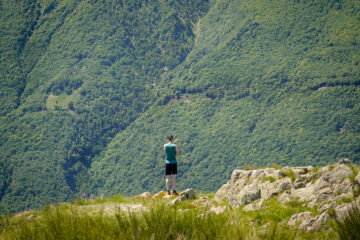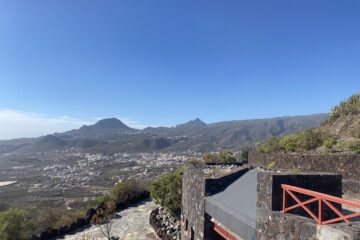This is not a usual blog post but instead a review of the glucose-measurement sensors sold by Supersapiens. Two reasons led me to write this review, first it makes for an interesting and different kind of blog post and second, I wanted to share my point of view as I felt like there were things not mentioned in other reviews.
First, I want to mention that I bought the sensors myself as I am not affiliated with Supersapiens. Furthermore, I want to be clear that this is not an in-detail review and therefore not something I would call a fully comprehensive (product-)review.
I can imagine that not all who read this are regular blog-readers or familiar with orienteering, I therefore thought about providing a bit of background information about myself to put my review and thoughts into context.
I am a 25-year-old German orienteer, living in Europe and am competing mostly as part of the national team. My training compares more or less to that of a middle-distance runner, with a weekly volume of 80-130k. I have an unofficial PB on 5k of 15:30′. For several years I´ve been working with a personal but also national team coaches. I would claim to know the basics of how to train but still like to explore new sports-tech and am always curious to understand more and improve.
In my opinion Supersapiens is for elite athletes in endurances sports, especially cycling, triathlon and running. To really benefit from the data, you need some coach who also has the expert knowledge to put the data into context and help you to make improvements in your training and racing. This does not mean that it is useless if you have the time and motivation to spend on logging, studying, testing, etc. but I wouldn´t expect to find drastic improvements as a result. While being super interesting, I think that in terms of improving performances this falls more into the category of optimizing the last percent for elite athletes. Although, I want to note that simply understanding the subject which Supersapiens deals with can already help you improve your fueling strategies.
So, lets begin. What led me to trying Supersapiens was mainly curiosity, partly motivated by the two famous Norwegian triathletes and their coach. I knew that my whole fueling strategy in racing as well as in training could be improved which was therefore my main goal. Even before I actually bought the sensors, I already started reading more into the topic of glucose-levels and the relation to training- and racing-performance. I continued this once I had the sensor applied which was aided by daily tips from Supersapiens which were recommending different things to test and usually were based on their own blog posts. The Supersapiens blog is therefore a great place to start learning more about it all. A big part of my learnings & take-aways (see bottom) are also coming from those posts as they did a good job of highlighting important topics.
I am writing this post after using one sensor so far (in March 2023), I have not yet applied a second sensor mainly because I wanted to first take a detailed look over the data from the first sensor. I have another sensor left as I took the monthly subscription but canceled that directly because I first want to test it before I spend monthly a fair amount of money on it.
A collection of different points
The (one) sensor worked perfectly fine for me, although the glue of the sensor´s sticker came slightly off at the edges after a few days, it did not get worse or seem to impact the data collection. I would say that I was careful with not hitting or accidentally pulling of the sensor but also agree with other reviews that they stick securely to your arm.
During the two weeks I had the (IOS) app open in the background the whole time, restarting it once a day to avoid problems. I am already a person who is generally in reach of their phone, but this was on a new level as I wanted to make sure to get the detailed one-minute interval data. This also meant that I carried my phone with me on my running session – yes I am old-school in that way – either in a running-belt or in a GPS-vest (for all non-orienteers think of it as a sports-bra but thinner, no chest-support and a pocket on the bag). The latter option I used mainly for intense/fast trainings due to its simplicity and comfort. I didn´t encounter any real problems with the app or imports of my training via Garmin. However, there is currently no option to automatically import sleep data via Oura for example which means you have to manual log this as well in addition to meals and other events.
While using the sensor, I logged a Food-diary in a spreadsheet in Notion with the goal in mind to understand different foods and their effects on my glucose-levels.
My original plan was to use the first sensor for getting some base-data and using the second sensor to test and compare in more detail. While this is still possible, I am a bit more unsure and pessimistic about what I should test for or could find out and further how that could help me improve. To be clear though, this is mostly because I learned already a lot or finally took the things I know more serious by reading more carefully into the whole subject.
Two major realizations were in the areas of ‘(under-)fueling‘ and ‘training your gut’. So far, I generally used energy-gels only in races and not during intense sessions or long runs in big part because I thought about it in the way that my body is positively adapting to this low-energy-supply situation. While this might be true in terms of handling hard and long efforts with less energy, I now think that the effect is not the desired one if my goal is improving (racing) performance. The other point partly explains itself already but to be more precise it refers to making your stomach comfortable with taking in high amounts of carbs during (intense) efforts. Furthermore, I now take (even) more care about the 4Rs after training sessions, especially long and intense ones. In addition, I am more aware that I probably could and should take in more carbohydrates in the days leading up to races so that I am making sure my energy-storage is filled up.
What you might have realized is that for all those take-aways the sensor didn´t really play a big role. This does not mean that I didn´t see the ‘positive’ impact of the energy intake in the graph but it was more a confirmation. I never managed to have levels which are to high for the glucose-performance-zone, so checking if I push my levels with energy intake too high didn´t seem to be a big issue for me. For my testing I bought a few different gels to test their impact on my glucose-levels, my stomach and their taste. Such testing is of course a good recommendation in general.
The graph, however, was helpful in showing me the impact of eating too close before sleeping or training. But again, once you are more read-in with the topic and aware of it, you generally don´t need your personal data from a sensor to make such adjustments.
Personally, my biggest ‘concern’ is also that for my situation the sensor won´t help me much further. On one side is the fact that I am mostly competing in races which are 10 to 40 minutes long and due to being orienteering competitions my energy-intake options are often limited to what I can reasonably carry with me. Furthermore, I have nowadays a rather robust gut, no eating limitations or allergies and eat already carbohydrate-rich meals. As a student and athlete, I can often arrange my trainings so that I can train most effectively which in most cases means that I run once my gut feels ready which also seemed to align with the measured levels from before the training.
I tried using vinegar multiple times before dinner and a few times before breakfast where my levels usually spiked quite steep and high. Sadly, I did not see that it was really reducing my glucose spikes. Another test was to eat a muesli a bit before dinner instead of after as an evening-snack or hunger-filler. This helped a bit in reducing the amplitude of the spike after dinner and therefore led to more stable levels before going to sleep. However, I would call these ‘results’ preliminary and will test it further with the next sensor.
My conclusion
I think Supersapiens is most useful for elite athletes in endurances sports, like cycling, triathlon and running, especially the longer disciplines of those, who might be able to optimize their training and racing strategies a bit further with the help of their personal glucose data. This does not mean that I think it is useless to everyone else, but I do think that there are potentially other knobs to dial in first for further improvement. At the same time, I think that everyone who is running slower than 3h on the marathon does not need to race in the best carbon shoes – so what do I know…
If you have the motivation, time and money, then try it. It is interesting and has the potential to be helpful. However, in contrast to for example a professionally adjusted bike position this is not guaranteed to improve your performance (by whatever metric) as it is up to you to test, analyze and adjust in order to make improvements.
If you´re still unsure, then start by reading more into the subject – again, a good place to start is the Supersapiens-blog and decide after that – maybe simply try only two sensors, like I am doing. For that, I added a few interesting links below. Don´t expect to be an expert after half an hour of reading though (neither am I), as this is a very specific subject which is still evolving as well.
While I am happy to answer specific questions in the comment section, I want to add that I won´t answer question which could easily be answered by your own research or reading through Supersapiens´ FAQ section.
PS: I already called this part one, so there probably will be a second part as well, once I used the second sensor and look more into the data.
I train and compete on a decent level, however, I don´t mean to include myself in the category of elite athletes which I am referring to in the above.
Just to have mentioned it, my training is still going strong and hopefully will soon translate into good results as well.



3 Comments
Mädi · 26. March 2023 at 18:24
You are an elite athlete .
ps. Thanks for the review. Out of curiosity, when you mention “…Another test was to eat a muesli a bit before dinner instead of after as an evening-snack or hunger-filler. This helped a bit in reducing the amplitude of the spike after dinner and therefore led to more stable levels before going to sleep”, so did you find this to affect your sleep in general or how fast you fell asleep? Or why “more stable levels before going to sleep” is the desired outcome?
Personally I often eat my evening snack (apple, youghurt, granola – ~500kcal) about 30-60minutes before going to bed (and normally) fall asleep quite quickly. Dinner often being ~3hours before bed time.
CK · 26. March 2023 at 23:22
Based on Supersapiens recommendations (see the link about ‘sleep’) stable glucose levels are what you should be going for while sleeping to have the best ‘recovery effect’. And glucose levels generally take a moment/longer than 1h to stabilise which I can confirm with my own data.
Generally, I used to do it the same way you describe and also had no problems in terms of felt sleep-quality and also would say that I did not see a difference in my Oura data but that does not mean the body´s recovery over night could be improved.
At the same time, I haven’t digged that deep into it yet either, so will try to check it out further with the second sensor.
The most positive change I implemented so far was really to intake energy on long/hard sessions and to quickly take in more energy after a session.
Mädi · 27. March 2023 at 13:20
Thanks for the info. I will dig deeper into this.
I’ll be curious to read the next part.